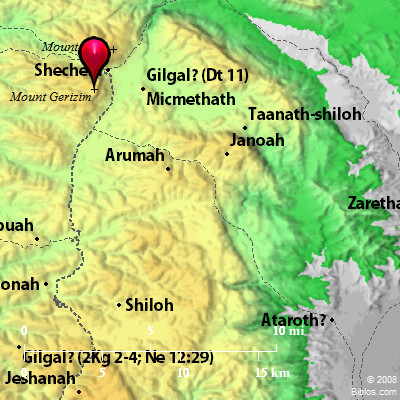Atlas  Mount Gerizim and surrounding area
Maps Created using Biblemapper 3.0Additional data from OpenBible.infoOccurrences Deuteronomy 11:29 It shall happen, when Yahweh your God shall bring you into the land where you go to possess it, that you shall set the blessing on Mount Gerizim, and the curse on Mount Ebal. Deuteronomy 27:12 "These shall stand on Mount Gerizim to bless the people, when you have passed over the Jordan: Simeon, and Levi, and Judah, and Issachar, and Joseph, and Benjamin. Joshua 8:33 All Israel, and their elders and officers, and their judges, stood on this side of the ark and on that side before the priests the Levites, who carried the ark of Yahweh's covenant, the foreigner as well as the native; half of them in front of Mount Gerizim, and half of them in front of Mount Ebal, as Moses the servant of Yahweh had commanded at the first, that they should bless the people of Israel. Judges 9:7 When they told it to Jotham, he went and stood on the top of Mount Gerizim, and lifted up his voice, and cried, and said to them, "Listen to me, you men of Shechem, that God may listen to you. Encyclopedia GERIZIM, MOUNTger'-i-zim, ge-ri'-zim (har gerizzim):
1. Scriptural References:
Named in the directions for the reading of the law (Deuteronomy 11:29), and in the account of that great ceremony (Deuteronomy 27:12 Joshua 8:33 f). Mts. Ebal and Gerizim stood over against each other, and on their sides the peoples were placed, half upon one and half upon the other, while in the vale which separates the mountains stood the ark, with the Levites. Those who stood on Gerizim responded to the blessings, those on Mt. Ebal to the cursings, as these were spoken "with a loud voice" by the Levites. From a spur of Mt. Gerizim Jotham spoke his taunting parable to the men of Shechem (Judges 9:7). The name appears no more in canonical Scripture. In consequence of the dispute which arose over the marriage of Manasseh, who belonged to the high-priestly family, with a daughter of Sanballat the Horonite (Nehemiah 13:28), a temple was built on Gerizim as a rival to that in Jerusalem (circa 432 B.C.). This was the beginning of the schism which lasts to the present day (Ant., XI, viii, 2, 4). See SAMARITANS. The temple was destroyed by John Hyrcanus circa 110 B.C. (Ant., XIII, ix, 1; BJ, I, ii, 6).
2. Description:
Mt. Gerizim, the modern Jebel et-Tur, stands on the South, Mt. Ebal on the North, of the narrow pass which cuts through the mountain range, opening a way from the sea to the Jordan. In the throat of this pass to the West, on the South of the vale, and close to the foot of Gerizim, lies the town of Nablus, the ancient Shechem. Here copious fountains rise, filling the valley with beauty and fruitfulness. The sides of the mountain are steep and rocky on East and North; on the West the ascent is more gradual, and here, by means of a system of terraces carried almost to the summit, it is cultivated with great care and success. Its height is 2,849 ft. above the level of the sea, 228 ft. lower than its northern companion.
3. Samaritan Traditions:
Abraham came through the pass and camped near Gerizim at the oak of Moreh (Genesis 12:6). According to Samaritan tradition it was on this mountain that he prepared to sacrifice Isaac, and at Salem, not far distant, he met Melchizedek (Genesis 14:17). The scene of Jacob's dream is placed at Khirbet Lauzeh on the summit (Genesis 28:11 f). In a little hollow West of the ridge, the Samaritans annually celebrate the Passover in accordance with the directions of the Pentateuch. This is done in the open air, their temple having long since disappeared.
4. Antiquities:
The most important remains on the mountain today are those of Justinian's fortress, built in 533 A.D., to protect the church which had been erected in 475 A.D. Near the center of the plateau is a bare piece of rock, on which, tradition says, the altar stood in the Samaritan temple. A cup-like hollow in it may have been used for libations. In the western wall of el-Qal`ah, Justinian's castle, there are 12 stones under which, it is said, are the stones which Israel took from the bed of the Jordan (Joshua 4:20).
Gerizim was certainly "this mountain" pointed to by the woman of Samaria in her conversation with Jesus (John 4:20 f); the cliffs of the mountain almost overhanging the Well of Jacob.
For the reason why Gerizim was chosen for the blessing and Ebal for the cursing we are left to conjecture. The directions were fixed by one looking to the East, not, as with us, looking to the North. For one standing in the valley, therefore, Gerizim was on the right hand, "the side of good fortune" (Driver, Deuteronomy on 11:28).
Onom places Ebal and Gerizim much nearer the Jordan valley. This was doubtless to meet the difficulty raised by the long distance from Ai to Shechem. But their nearness to the "oaks of Moreh" (Deuteronomy 11:30) points to this locality, and this is confirmed by Josephus, who speaks of Shechem, the metropolis of the Samaritans, as "a city situated at Mt. Gerizim" (Ant., XI, viii, 6).
Andronicus, appointed governor of Gerizim by Antiochus Epiphanes, is mentioned in 2 Maccabees 5:23 (the King James Version "Garizim").
W. Ewing
GER'IZIM, Mt., s. of Shechem, 2849 ft. above the Mediterranean and about 950 ft. above Shechem. See Ebal. |




